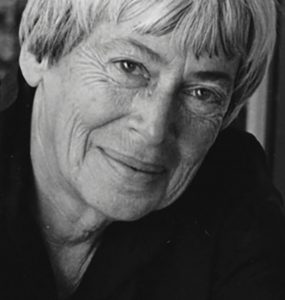Alison Smith in Granta:
 In 1987, my first year in college, I happened upon a notice outside of the English department for a winter session opportunity: escorting a visiting artist during a week-long interdisciplinary conference held at my school, the University of Rochester. I ran my finger down the list of artists’ names until it stopped on one: Ursula K. Le Guin.
In 1987, my first year in college, I happened upon a notice outside of the English department for a winter session opportunity: escorting a visiting artist during a week-long interdisciplinary conference held at my school, the University of Rochester. I ran my finger down the list of artists’ names until it stopped on one: Ursula K. Le Guin.
At eighteen, I had never met a published author (unless you count the time I stood in line for an hour to have Kurt Vonnegut sign my copy of Slaughterhouse-Five), and this was not any published author, this was Le Guin. I scanned the notice for application information. Applicants were required to write an essay on why they would be a good student guide and to list their preferred artists. The deadline was that day. I sat down in the hallway and scribbled out a plea on the back of the notice. I don’t remember what I wrote, but I am sure I mentioned my worn copy of The Left Hand of Darkness and the first line, which I had memorized. A line that contained a thrilling twist on the nature of reality: ‘I’ll make my report as if I told a story, for I was taught as a child on my homeworld that Truth is a matter of the imagination.’
I slipped the paper under the door – the office had already closed. A week later I received a call from the department secretary. I had been assigned an artist. ‘Who?’ I asked, gripping the receiver. There was a pause. I heard papers shuffling, and then: ‘Ursula K. Le Guin.’
More here.
